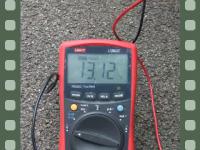Just popped over 20K yesterday on the 09er; on previous bikes I've tried for 20K on the fork oil, so a few weeks back I read through some posts here on the topic--the owners manual doesn't seem to list suggested miles for fork maintenance?
I do about 60/40 two-up, as higher mile trips are often with the two of us, which obviously weights the shock more. What was of interest here on the forum was finding comments about, "skipping fork oil changes, because at 35K the bushings will be shot, so wait until there is a clanking noise and then rebuild the forks . . ." words to that effect?? Seemed like a mixed bag on the recommends, some saying, "Change the oil . . . sometime . . ." and the others saying, "Thrash them, then go for total rebuild . . ." ???
Personally I try to keep up with regular maintenance to push total rebuilds down the road as far as possible??? No? I'll be "lucky" if I get 30Kout of the forks?? Generally I ride slower than "an old lady" . . . although I'm starting to figure out the 5 speed gear ratio throttle spring/rev limiter thing . . . .
Another question, is there a min. battery voltage to run the Gen II machine? A couple weeks ago I check the voltage standing on the battery at 12.98 V . . . yesterday the co-pilot left her electric vest on in stop light to stoplight traffic after landing from the local highway, and on re-start from unlocking garage door the fan was blowing and the engine barely cranked for a minute, I thought the battery was "depleted" even though I was keeping the Rs up as much as possible in traffic 2500-400K . . . but, it fired and I pulled in to park it. Even though the bike had been running for a couple hours straight the battery showed 12.74 V. Put it on the charger for a couple hours and it came up to 12.98V . . . I usually like to run the batts down to somewhere under 12 before I replace them, but seems like that might be a problem on the FJR?? Needs fresh clean juice from a fresh new battery every couple years??
I do about 60/40 two-up, as higher mile trips are often with the two of us, which obviously weights the shock more. What was of interest here on the forum was finding comments about, "skipping fork oil changes, because at 35K the bushings will be shot, so wait until there is a clanking noise and then rebuild the forks . . ." words to that effect?? Seemed like a mixed bag on the recommends, some saying, "Change the oil . . . sometime . . ." and the others saying, "Thrash them, then go for total rebuild . . ." ???
Personally I try to keep up with regular maintenance to push total rebuilds down the road as far as possible??? No? I'll be "lucky" if I get 30Kout of the forks?? Generally I ride slower than "an old lady" . . . although I'm starting to figure out the 5 speed gear ratio throttle spring/rev limiter thing . . . .
Another question, is there a min. battery voltage to run the Gen II machine? A couple weeks ago I check the voltage standing on the battery at 12.98 V . . . yesterday the co-pilot left her electric vest on in stop light to stoplight traffic after landing from the local highway, and on re-start from unlocking garage door the fan was blowing and the engine barely cranked for a minute, I thought the battery was "depleted" even though I was keeping the Rs up as much as possible in traffic 2500-400K . . . but, it fired and I pulled in to park it. Even though the bike had been running for a couple hours straight the battery showed 12.74 V. Put it on the charger for a couple hours and it came up to 12.98V . . . I usually like to run the batts down to somewhere under 12 before I replace them, but seems like that might be a problem on the FJR?? Needs fresh clean juice from a fresh new battery every couple years??






![fjackets Real Lambskin Leather Biker Jacket — Quilted Cafe Racer Zip Up Moto Leather Jackets For Men | [1100085] Johnson Brown, XL](https://m.media-amazon.com/images/I/41I7Pm1f+vL._SL500_.jpg)

























































